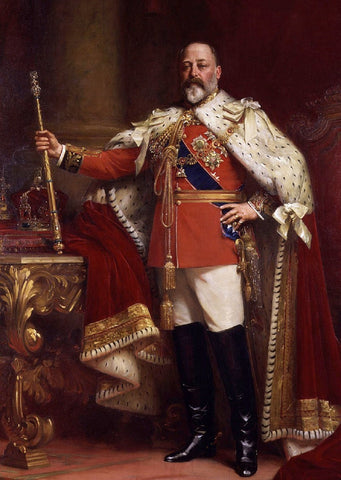#Ultimate #Guide #Buying #Authentic #Edwardian #Jewellery
.
This guide will show you how to guarantee that you are buying authentic Edwardian jewellery.
While other blogs deal with Edwardian style and fashion we are endeavouring to compile a guide to enable accurate dating.
Some purists would say that the term Edwardian can only be used to describe antiques made in the United Kingdom / dominions of King Edward VII. For example King Edward VII was not the king of America and so some people may think it is a little strange to describe American made jewellery as “Edwardian”.
You may or may not feel as though this is a little pedantic.
The Edwardian era was a very short period of time.
KING EDWARD VII
Oil on canvas by Sir Samuel Luke Fildes (1843-1927)
National Portrait Gallery
King Edward VII reigned from 22 January 1901–6 May 1910.
During his reign Edward VII declared that the peridot was his favourite jewel and as a consequence it was very popular during this era.
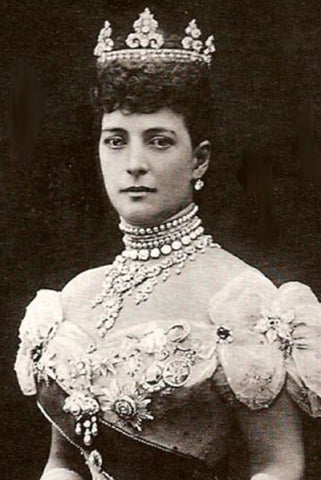
QUEEN ALEXANDRA
His Consort, Queen Alexandra, was a trend setter who delighted in wearing ornate jewellery. She usually wore chokers to cover a scar on her neck which resulted from an operation which took place in her childhood. Some of these chokers were multi-strands of pearls. In the Edwardian era ornate gem set jewellery, lockets and chokers were very fashionable .
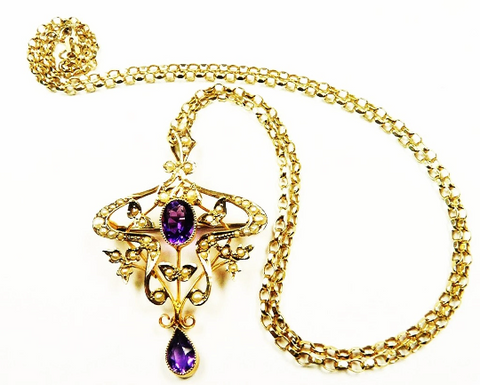
VIEW THIS EDWARDIAN GOLD PEARL & AMETHYST NECKLACE
Antique jewellery is valuable and sought-after because of its rarity and also the high level of skill involved to create such ornate pieces which surpass mass produced modern jewellery.
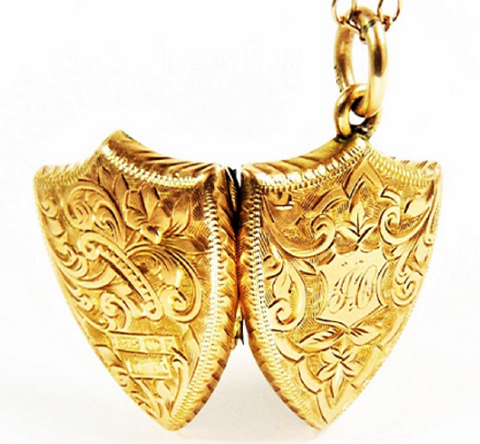
Typically, antique lockets from the Victorian and Edwardian era are far more ornate than those crafted in the 1930s to the modern day.
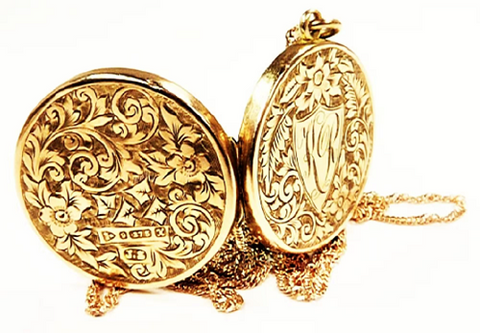
VIEW THIS FULLY HALLMARKED EDWARDIAN LOCKET
Some authentic antique jewellery is not hallmarked. However, many potential purchasers may lack the confidence to part with considerable amounts of money if the piece does not bear hallmarks.
Other authentic antique jewellery will be stamped with 9c or 9ct for 9 carat gold or 15c or 15 ct to give some examples. Although there may not be full sets of hallmarks and therefore no date letter we can be confident of its authenticity because of the exquisitely fine workmanship and ornamentation.
From 1904 the carat value of gold was also shown as a decimal.
9 carat gold has a decimal value of .375.
The decimal value for 15 carat gold is .675.
Sterling silver has the decimal value of .925.
Reproductions often lack extremely fine workmanship and may be one of many identical pieces of jewellery.
Crucially, we do not find multiple identical items from the Georgian, Victorian or Edwardian eras.
Beauty is in the eye of the beholder and many people feel confident buying from experienced sellers even when jewellery is not hallmarked.
This guide is for people who would like to see hallmarks which prove the age of the antique jewellery and leave no room for doubt.
Unfortunately, many people are confused by clever wording and they lack the time to source antiques. Then they part with hundreds of £s or $s for an item which was mass produced in the twenty-first century.
The use of the terms “antique style”, “Victorian style” or “Edwardian style” in an advertisement means only that these items are fashioned to have the appearance of jewellery from a much earlier era. Often these items are modern mass produced pieces. If you see multiple identical pendants, necklaces or bracelets they could be reproductions.
How is it possible that the descriptions which are affixed with the word “style” cause people to believe that they are buying antiques?
Some customers may be looking for a less expensive alternative which has an antique appearance.
Would these customers be as happy if the reproduction was just as expensive as an antique? Who knows?
Taste is unique to each person.
Sometimes the prospective purchaser believes that they are looking at an antique piece and does not have the knowledge to know how to date the item.
This post will show you how to date British assayed gold and silver.
If you are unsure about how to proceed we recommend purchasing jewellery with full sets of British hallmarks to guarantee the purity of the precious metal and the antiquity of the piece.
Once you know how to read assay offices’ date letters you will have the knowledge you need to date jewellery.
Do not worry, it is easy when you know how.
We will now show you how to date British made antique jewellery from the Edwardian era. These techniques can be used to date antique jewellery from different eras.
Unfortunately, throughout history precious metals have been faked. Those found guilty were dealt with extremely harshly, often by capital punishment.
The system of hallmarking was introduced in Britain to prevent this fraud.
When and why was a British system of hallmarking established?
In order to prevent goldsmiths from passing off items made from base metal or low grade alloys as gold or silver laws were passed.
In 1300 Edward I passed a statue commanding that:
no goldsmith… shall from henceforth make or cause to be made any manner of vessel, jewel or any other thing of gold or silver except it be of the true alloy….. and that no manner of vessel of silver (or gold) depart out of the hands of the workers, until further, that it be marked with the leopard’s head.
At this time there were no assay offices, instead men known as the Guardians of the craft would travel to goldsmiths’ premises to apply the leopard’s head mark.
In 1363 Edward III passed an ordinance that each goldsmith was required to have their own maker’s mark which would be unique to them. This mark must be stamped alongside the leopard’s head mark.
In 1478 one body, the Goldsmiths’ Company, was made responsible for guaranteeing the purity of precious metals. The Company would issue fines when wares were below the standards that had been set in statute. The leopard’s head with a crown was introduced at this stage as well as a date letter for each year. The Goldsmiths’ Hall was granted the status of a permanent assay office.
In 1773 the House of Commons found in favour of a commission to establish assay offices in Sheffield and Birmingham.
Punishment for counterfeiting hallmarks.
In 1757 a law was passed which ensured that anyone found counterfeiting hallmarks in Britain would face the death penalty, as this offence had become a felony.
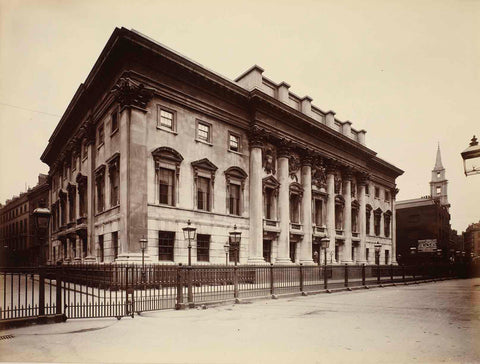
GOLDSMITHS’ HALL PHOTOGRAPHED IN 1895
© The Goldsmiths’ Company
The Goldsmiths’ Company gained its Royal Charter in 1327. In 1300 King Edward I passed a statute requiring that gold and silver be of a defined standard. These precious metals were to be marked with a leopard’s head. This hallmark was said to have been taken from the royal arms. Hence its name, the King’s mark. The Goldsmiths’ Company was tasked with the job of supervising Britain’s first hallmarking system.
This process has guaranteed the fineness of precious metals in Great Britain since the fourteenth century.
Buying fully hallmarked gold and silver will protect your investment and guarantee the purity of the gold/silver.
The word hallmark derives its name as the precious metals were marked in the Goldsmiths’ Hall. Craftsmen were required to bring their goods to the Hall for assaying and marking.
Imported gold and silver from 1842 – 1998.
From 1842 it was illegal to sell imported gold or silver in Great Britain until it had been presented to be tested (assayed) at a British assay office. In 1867 the Foreign Mark was added.

FOREIGN MARK
Knowing how to use the hallmarking system will guarantee that the jewellery you purchase will be an antique.
The first thing that you need to know is to which assay office the jewellery was presented to be assayed* (tested for purity*).
Then you need to find the date letter on the date chart for that office office.
Using the sets of hallmarks below we will decode the process.

BIRMINGHAM ASSAYED GOLD
The first mark H M is that of the makers, Henry Matthews. This is followed by the gold purity marks of 9 & .375 denoting 9 carat gold. Then we see an anchor which represents Birmingham Assay Office. Once you know the assay office you can peruse their date letter charts to see when the jewellery was made, as long as the date letter is not worn. In this example the date letter is a little difficult to see (far right) but when viewed through a jeweller’s loupe one can see that it is a lower case l. View the item from different angles to gain a better view of the date letter.
The font of the letter and the cartouche surrounding the letter will distinguish it from another letter l. The date letter charts repeat the alphabet.

MARK OF BIRMINGHAM ASSAY OFFICE
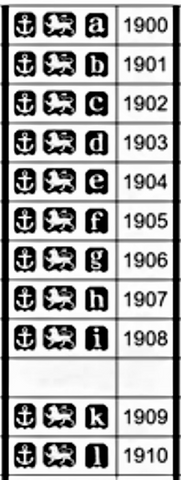
BIRMINGHAM DATE LETTERS
The chart above shows only the Edwardian era date letters for Birmingham assayed silver. The lion passant mark (middle) denotes sterling silver.
The date letters for gold and silver are the same.
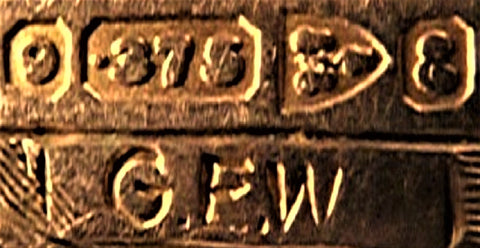
CHESTER ASSAYED GOLD
The gold above is stamped with the gold purity marks 9 & .375.
This is followed by the Chester Assay Office mark. The mark for Chester is a shield bearing the town’s arms, a sword and three sheaves of wheat. The date is an ornate letter E for 1905. The maker is G. E. Walton Ltd.
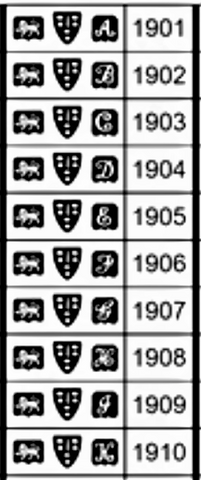
CHESTER DATE LETTERS
The chart above shows only the Edwardian era date letters for Chester assayed silver and gold.
The dating is also applicable on imported gold and silver because it had to be presented for assaying on import.
We know the hallmarks below refer to an imported item because of the F hallmark which denotes foreign.

LONDON ASSAYED GOLD
The importer’s mark P E (Paul Ettlinger) the gold purity marks 9 & .375 (9 carat gold) are shown first. Followed by the Foreign Mark, the date letter i (1904) and the leopard’s head which represents London Assay Office.
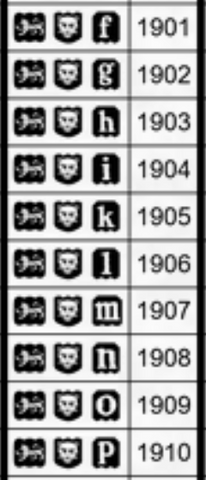
LONDON DATE LETTERS
The chart above shows only the Edwardian era date letters for London assayed silver and gold.
You are mostly likely to see Birmingham, London or Chester assayed gold during your hunt to find an authentic Edwardian piece.
However, there are other assay offices which operated in the Edwardia era.
For example Sheffield, Glasgow and Edinburgh.
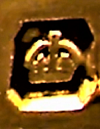
MARK OF SHEFFIELD ASSAY OFFICE
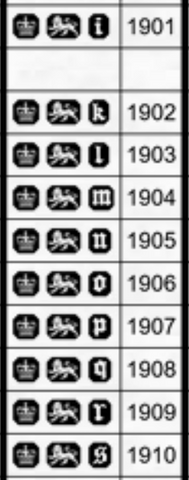
SHEFFIELD DATE LETTERS
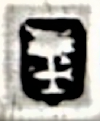
MARK OF GLASGOW ASSAY OFFICE
Glasgow Assay Office is represented by a tree, a bell and a fish, the city’s crest.
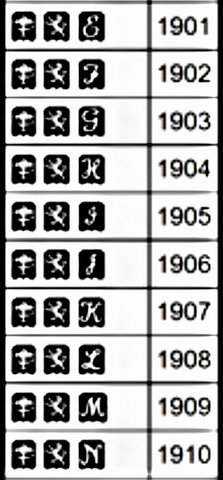
GLASGOW DATE LETTERS
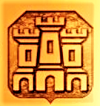
MARK OF EDINBURGH ASSAY OFFICE
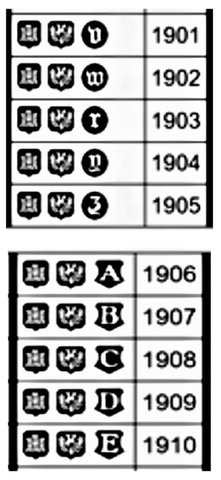
EDINBURGH DATE LETTERS
The marks above show a three towered castle and a thistle for Edinburgh assayed precious metal in the Edwardian era.
Ideally you should study the hallmarks prior to purchase if you wish to source an antique from a particular era.
Reading the hallmarks:
If you have already purchased the item and the date letter is too worn to read even with a jeweller’s loupe, a high spec. camera may be able to capture an image which is easier to determine.
Make sure that you illuminate the area with the hallmarks and point the camera as close as you can after setting it on auto focus. If you do not have studio lights an office table lamp will be bright enough.
Failing this, knowing the maker may be able to help you date the item. If you know when this firm of goldsmiths operated from and when they ceased to trade it may give you an idea of the antiquity of your newly acquired jewellery.
Specialist jewellers selling hallmarked jewellery will be only too happy to send good quality images of the hallmarks for you to read.
Hallmarked only on the hanging ring:
Some jewellery may only have a full set of hallmarks on the hanging ring (bale). This only guarantees the gold or silver purity of the hanging ring and does not pertain to the locket or pendant etc. In these situations we would expect that the main body of the locket or pendant would also be fully hallmarked. The bale is detachable and so it is possible that a solid gold fully hallmarked bale could be attached to a pendant which is only gold plated.
We include images of the hallmarks on our listings.
We recommend sourcing fully hallmarked gold or silver to protect yourself and your investment.
Gold purity is just as much an issue as dating. Many sellers describe items as “tests as gold” or “gold back and front” which can be confusing. The article below will give you a complete understanding of what is and is not solid gold.
More information about gold purity etc.
View our fully hallmarked antique gold locket collection.
More information about goldsmiths Joseph & Paul Ettlinger.
Please note that although we spend many hours each week updating or compiling new work for our historical blog section which is free to view, we do not offer an appraisal, identification, valuation or dating service to members of the public.
Sources:
silvermakersmarks.co.uk
theassayoffice.com

